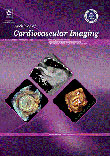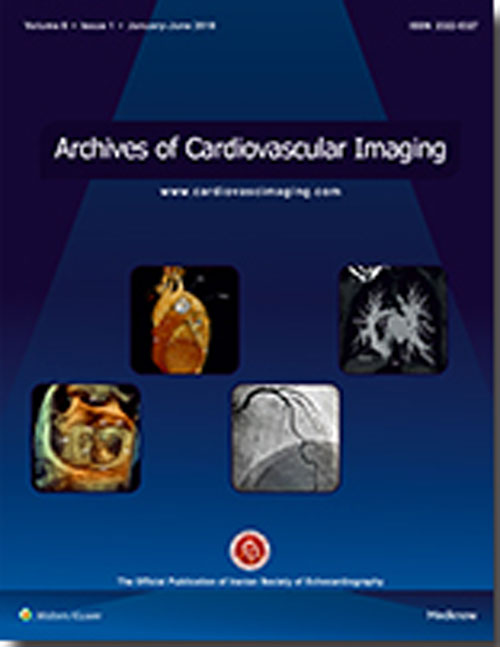فهرست مطالب

Archives Of Cardiovascular Imaging
Volume:3 Issue: 2, May 2015
- تاریخ انتشار: 1394/06/08
- تعداد عناوین: 6
-
-
Page 2IntroductionMultimodality imaging can help rule in/out the diagnosis of hypertrophic cardiomyopathy (HCM) in patients with significant left ventricular (LV) hypertrophy..Case PresentationWe describe a 73-year-old woman referred to us for consultation because of a giant negative T wave on her electrocardiography. Echocardiography revealed diffuse severe hypertrophy associated with hypertrophied anterolateral papillary muscles with a bifid head and with extensive wall insertion into the apicolateral segment. Three-dimensional echocardiography and cardiac magnetic resonance confirmed these data. Importantly, automated function imaging determined the global longitudinal strain at -10.2%..ConclusionsAccording to our multimodality imaging approach, hypertrophic cardiomyopathy was the most probable diagnosis..Keywords: Multimodality Imaging, Hypertrophy, Left Ventricular, Anomalous Papillary Muscle, Global Longitudinal Strain
-
Page 3IntroductionWe describe a 56-year-old woman with dilated cardiomyopathy, whose clinical assessment, including two-dimensional echocardiography, demonstrated a spherical left ventricular geometry with severe left ventricular enlargement and dysfunction as well as reverse apical rotation. Left ventricular twist and torsion were evaluated via echocardiography with velocity vector imaging; the patient was found to have reverse rotational movement. We hereby address these issues from an echocardiographic point of view..Case PresentationThe patient was a 56-year-old woman, who referred to our clinic with complaints of dyspnea on exertion of 2 years’ duration. By the time of her referral, the patient’s dyspnea had exacerbated and reached New York Heart Association (NYHA) functional class III.ConclusionsThese findings emphasize the potential clinical benefits of therapeutic procedures such as cardiac resynchronization therapy (CRT) or apex-sparing volume-reduction surgery in DCM. A better definition of the role and implications of reverse apical torsion in DCM and its importance and effectiveness in making therapeutic decisions like CRT implantation requires further studies..Keywords: Torsion, Left, Dilated, Cardiomyopathies
-
Page 4BackgroundCoronary artery disease (CAD) is prevalent but very difficult to diagnose in hemodialysis (HD) patients compared with non-uremic individuals..ObjectivesThe aim of this study was to detect undiagnosed ischemic heart disease (IHD) using dipyridamole myocardial perfusion imaging (MPI) in HD patients..Patients andMethodsIn this cross-sectional descriptive study, HD patients who met the inclusion criteria were selected. Demographic, clinical, and paraclinical data were obtained via interviews and medical records. Bedside electrocardiography, resting echocardiography, and nuclear MPI with dipyridamole were done. The data were analyzed using descriptive statistical methods for detecting the prevalence of undiagnosed IHD in the HD patients. The chi-square test and the independent t-test were used to identify the high-risk HD patients..ResultsSixty-nine HD patients were studied using dipyridamole MPI with Tc 99 m sestamibi. The mean age, body mass index, and mean duration of HD were 52.1 ± 13.8 years, 21.23 ± 4.79 kg/m2, and 48.2 ± 34.9 months, respectively. The patients were divided into two groups based on MPI: IHD-positive group (21.7%) and IHD-negative group (78.3%). IHD was more prevalent in the patients with diabetes mellitus, hypertension, positive family history of CAD, low HD adequacy index (Kt/V < 1.2), left ventricular hypertrophy, high intact parathyroid hormone levels, electrocardiographic abnormalities, and low ferritin levels. A statistically significant correlation was also detected between IHD and aging (P < 0.05)..ConclusionsThe prevalence of undiagnosed IHD in the HD patients was considerable. We, therefore, suggest that IHD be assessed in HD patients, especially those at high risk due to positive family history of CAD, hypertension, left ventricular hypertrophy, diabetes mellitus, Kt/V < 1.2, low ferritin levels, and high levels of intact parathyroid hormone..Keywords: Hemodialysis Patients, Ischemic Heart Disease, Dipyridamole Myocardial Perfusion Imaging (MPI)
-
Page 5BackgroundMotion artifacts that degrade image quality of coronary CT angiography (CCTA) in patients with high heart rates may be reduced with specific automatic motion correction algorithms (AMC)..ObjectivesWe compared coronary-artery delineation between AMC and conventional CCTA reconstruction (CR)..Patients andMethodsCCTA images (clinical single-source-64-slice-CT system) of 17 consecutive patients with heart rates exceeding 55 bpm were reconstructed with both CR and AMC during the individually best-suited phase of the cardiac cycle. Two independent readers who were blinded to the reconstruction algorithm scored image quality of each coronary artery segment (AHA 15-segment-model; 1: non-diagnostic - 4: excellent). In case of disagreement a third blinded reader assigned a final score. Two-tailed statistical tests (Wilcoxon-matched-pairs, Pearson-correlation) were significant at P < 0.05..ResultsMean heart rate during CCTA was 61 ± 8 bpm. CCTA quality improved significantly in the RCA (good-or-excellent in 11/17 AMC vs. 5/17 CR, P = 0.018) and LAD (15/17 vs. 7/17, P = 0.031). Non-diagnostic CCTA in the RCA, LM, LAD, and LCX reduced from 16/68 (CR, 24%) to 7/68 (AMC, 10%). Significant motion correction was observed at low (≤ 60 bpm; P = 0.008), intermediate (61-70 bpm; P < 0.001), and high heart rates (> 70 bpm; P = 0.021). Inter-reader agreement was good. (inter-class-correlation, 0.762)..ConclusionsCCTA image quality improves significantly with AMC in patients with high heart rates and reduces the proportion of non-diagnostic examinations..Keywords: CCTA, Motion Correction, Image Quality
-
Page 6BackgroundCardiovascular diseases increase morbidity and mortality in patients with systemic lupus erythematosus (SLE).The cardiac involvement could be silent. Echocardiography can be used as a noninvasive tool for the assessment of the ventricular function..ObjectivesWe sought to evaluate different echocardiographic parameters via tissue Doppler imaging and speckle-tracking echocardiography (STE) in addition to conventional echocardiography..Patients andMethodsThis case-control study was conducted in 45 SLE patients (88% female; mean age = 31.2 ± 8.2 years) and 25 healthy controls (87% female; mean age = 30.3 ± 7.7 years), matched in terms of age and sex. Both groups had no clinical signs and symptoms of cardiac problems or risk factors for cardiovascular diseases. Both SLE and control groups underwent echocardiography for the assessment of the ventricular function and the sizes and diameters of the chambers. Two-dimensional STE was used for the measurement of the left ventricular (LV) global longitudinal systolic strain..ResultsThe mean duration of SLE was 5.5 ± 3.4 years in our patients. No significant difference was found between the two groups concerning the LV and left atrium size, LV ejection fraction, right ventricular (RV) systolic function, RV and LV diastolic function, and pulmonary artery pressure. The LV global longitudinal strain was less in the SLE patients (-18.56 ± 2.50% vs. -19.89 ± 1.94%; P = 0.028). The LV mass was greater, though not statistically significant, in the SLE patients (111 ± 29.54 g vs. 104.37 ± 27.39 g; P = 0.468). The interventricular septal diameter was thicker in the SLE patients (0.79 ± 0.15 cm vs. 0.77 ± 0.10 cm; P = 0.046)..ConclusionsSilent ventricular systolic dysfunction was more common in the patients with SLE than in the control group. Newer echocardiographic techniques such as two-dimensional STE provide an earlier chance for the detection of subclinical LV systolic dysfunction. Our findings were independent of the traditional risk factors..Keywords: Systemic Lupus Erythematosus, Echocardiography, Left Ventricle


